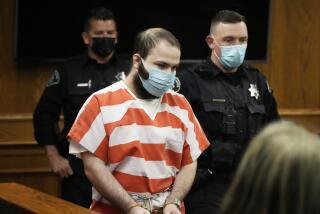Attias Faces No Easy Future After His Committal to Mental Hospital
He plowed his high-powered Saab through a crowd of pedestrians near UC Santa Barbara last year, then jumped from his car shouting: “I am the angel of death!”
Last month, a jury convicted David Attias of four counts of second-degree murder--a verdict that would have sent the 20-year-old college student to prison for at least half a century.
But eight days later, the same Santa Barbara jury found Attias legally insane. That vastly changed the young man’s prospects; technically, he could be set free in just half a year.
When a judge committed Attias on Friday to Patton State Hospital in San Bernardino, the outcome renewed the debate over the treatment of the mentally fragile one-time college student, who looks more like Harry Potter than a wild-eyed killer. Outraged relatives of those who were killed as they strolled along an Isla Vista street see a pampered young man.
Some fear he will win release from the hospital in just a few months or years, perhaps benefiting from the connections of his television director father.
Defense lawyers say their client’s path won’t be nearly that easy. They predict that Attias will be locked away in a mental hospital for much of his life.
Maybe all of it. Connections don’t count at Patton State Hospital, they say, and it’s no country club.
There may be truth in both arguments.
Attias would have been sentenced to 60 years to life in state prison and, under the law, would have had to serve more than 50. In the state’s toughest prisons, his surroundings would have been extremely unforgiving.
In contrast, at a state mental hospital, he at least has the opportunity for an earlier release. But Attias does not face an easy future at Patton, where he will endure a world of regimentation, medication and therapy that can be described as lenient only when compared with a life in prison.
Contrary to some popular belief, it historically has been tougher to get out of mental hospitals in California than prisons. A 1985 study of confined murderers showed that those who went to mental hospitals spent an average of more than seven years there, while those sent to prisons remained an average of less than four years.
That has changed as the result of almost two decades of increasingly tough laws and policies. Murderers sent to prison now spend at least twice as much time locked up as those placed in mental hospitals, officials estimate.
A life sentence for first-degree murder often means just that now. And most convicted of second-degree murder are kept beyond the 15-year minimum, even though they are eligible for parole after 85% of that time has been served, officials say. Attias would have been sentenced to four consecutive terms of 15 years to life.
To be freed from a state mental hospital, a patient must be cleared by hospital psychiatrists, community mental health officials and, finally, a judge. All must be convinced that the patient is sane, able to function in society and no longer a danger to himself or others.
Those confined to the hospitals have found it increasingly difficult to win their freedom.
“There is a probability he will never get out,” Dr. Kaushal Sharma, a clinical psychiatrist in Newport Beach predicted of Attias. Sharma is a frequent trial consultant on insanity issues and former Patton State Hospital advisor.
“At Patton there is a dual role--to treat, but also to protect society,” Sharma said. “The staff isn’t going to be jumping up and down to let him out tomorrow. Meanwhile, he will be profoundly better off than in a prison.”
*
Patton State Hospital may be a far cry from the grim lockdown life in the state prison system, but it is far from cushy.
There are trees and open space. But there is barbed wire, too, and Department of Corrections guards patrol the perimeter.
There are about 250 patients in the state’s four mental hospitals who have committed homicides, 156 of them at Patton. That compares with a total of 22,000 in the state prison system, just one indication of how infrequently insanity defenses have been attempted and have succeeded.
Ultimately, hospital officials said, Attias will probably end up in one of the 1,300-patient facility’s long-term care units. But in the next few days, he can expect to be in Admissions Unit.
Wake-up is at 6 a.m. Then patients make their beds, wash and eat breakfast. Morning medications are at 8. Then there are “treatment groups” that range from music appreciation to anger management and weight training.
A regime of head counts, multiple medication breaks and some leisure time continues through the day. Lights out: 10 p.m.
“This kid’s going to be frightened when he comes here,” said Brad Smith, chief of the hospital’s forensic office and the main liaison between the hospital and the courts.
“But our atmosphere is very different than prison,” Smith said. “There is a very different type of a mental reality here. We are trying to get our patients to realize they are part of the human race.”
On a recent morning, the mood was peaceful on the grounds and inside the hospital wards. Outside, a small group of Native American patients formed a circle in one area, chanting. Others sprawled on the grass or sunned themselves on benches.
In one of the long-term care units, Edward Charles Alloway sat alone on a cot. Now 64, Alloway was found not guilty by reason of insanity after a 1976 shooting spree at Cal State Fullerton that killed seven people. A judge blocked his latest attempt for release last December, saying Alloway remains a danger to the community.
Eventually, Attias is also likely to end up in a long-term care unit in a room with three others. The patients sleep on cots and the walls are bare.
The average homicide commitment at Patton is more than 10 years, officials said. But many, like Alloway, are there much longer, and some will never get out, hospital psychiatrists said.
The exception is a patient like Alfred Polhmeier, a Ventura County man who strangled his wife for snoring. Polhmeier spent a little more than a year at Patton before his release to a community care program and, finally, to his family in 1999. But he was 94 and nobody saw him as a danger.
*
Along with the state hospitals, a key component in dealing with legally insane criminal defendants is California’s Conditional Release Program, known as ConREP, which was established in 1986. There are 21 locally run agencies treating 720 patients in facilities that operate like half-way houses.
If one of those agencies disagrees with the psychiatrists about a patient’s potential danger to society, it can block release. That happened in a multiple murder case as recently as February, when Ventura County ConREP officials blocked the movement of a double-homicide patient Miguel Hugo Garcia, 48, from Patton into community treatment.
High-profile murder cases get particularly intense scrutiny, at all levels, experts agreed.
“One of the things we have to take into account is strong community sentiment,” said Dr. Stephen W. Mayberg, state mental health director. “We might decide [the patients] aren’t strong enough yet to face that.”
John Vacca, a Los Angeles County public defender who now heads central felony operations, formerly supervised his office’s mental health legal department.
“The liberal psychiatrists, if there ever were some, have fled to the hills long ago,” Vacca said. “It’s a complete myth to believe that there are hordes of psychiatrists waiting to say, ‘Let this person go.’ ”
There is widespread agreement with that view among psychiatrists. And for good reason, they said.
“The reality is that there is great concern on the part of mental health professionals to be very conscious of the possibility of repeated violence,” said Dr. Ron A. Blanchette, a psychiatrist who has worked in both public and private sectors in Los Angeles and Ventura counties.
*
While the average stay in mental hospitals has been slowly increasing, any individual’s time of commitment remains uncertain. The length of Attias’ term in state prison would have been more definite.
The average prison term for murder in California has skyrocketed, with determinate sentencing rules and tougher penalties for violent crimes.
“Back in the ‘70s, you could try for parole after seven years in first-degree murder convictions,” said Ventura County Dist. Atty. Michael D. Bradbury, twice head of the state District Attorneys Assn. during 24 years in office. “I remember cases where people actually got probation for second-degree murder.” Parole for murderers is virtually unheard of during the administration of Gov. Gray Davis--who has paroled only two murderers since taking office.
Those convicted of a single second-degree murder now probably average more than 20 years behind bars, according to Marilyn Kalvelage, chief of institutions operations for the state Department of Corrections.
*
Volumes have been written on the question of legal sanity and how juries decide who goes to prison and who goes to a state hospital.
But mental health and law enforcement officials agree that emotion, rather than logic, often is the determining factor. Juries tend to imprison those they fear most, regardless of their level of sanity.
Some of the murderers doing time in state prison have more serious mental problems than most of their counterparts at Patton, the experts say.
“If you are really scary, a Jeffrey Dahmer or somebody like that, you’re going to be found guilty” and sent to prison, said Bradbury, the district attorney. “A jury isn’t going to take a chance that you will ever be able to get back out.... The really crazy people? A lot of them are roaming the cell blocks.”
The state’s top mental health official agreed.
“I can’t prove this, but I think that when crimes are really, really bad, juries find these people guilty,” Mayberg said. “They do take the nature of the crime into consideration.”
Throughout his trial, Attias projected a nonthreatening image.
“I’m sure the courtroom appearance didn’t hurt,” said public defender Vacca. “But I thought there also was a strong showing of prior mental illness on his part. Assuming you have a person who clearly is mentally ill, they are much better off in a mental hospital than state prison.”
More to Read
Sign up for Essential California
The most important California stories and recommendations in your inbox every morning.
You may occasionally receive promotional content from the Los Angeles Times.










